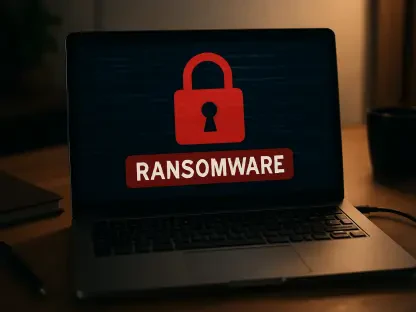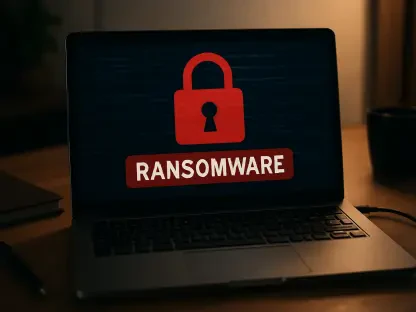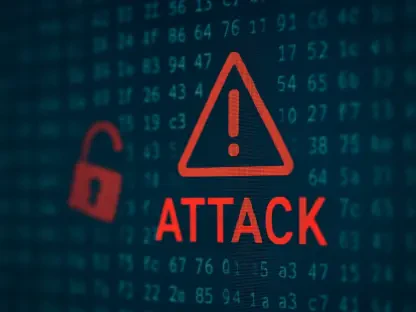The healthcare sector finds itself at a critical juncture as ransomware attacks grow more sophisticated and insidious, presenting unprecedented challenges for providers striving to protect sensitive patient data. A recent comprehensive survey of 292 IT and cybersecurity leaders from healthcare organizations across 17 countries, conducted between January and March by an independent research firm, offers a stark glimpse into this evolving threat landscape. Covering organizations with staff counts ranging from 100 to 5,000, the findings highlight a disturbing mix of technical vulnerabilities and human resource constraints that leave the sector exposed. Ransomware is no longer merely a matter of locking data; it has morphed into a complex game of psychological pressure and reputational risk. This article delves into the latest attack strategies, financial repercussions, and the profound toll on those tasked with defending against these relentless cyber threats, painting a picture of a sector under siege yet showing signs of resilience.
Emerging Attack Vectors and Tactics
Shifting Methods of Intrusion
A notable shift in ransomware attack methods has emerged, with exploited vulnerabilities in unpatched systems and software flaws now identified as the primary entry point for attackers, impacting 33% of reported incidents in healthcare settings. This marks a significant change from previous years when credential-based breaches held the top spot, signaling that adversaries are increasingly targeting outdated or unsecured infrastructure. The urgency for robust patch management and timely system updates cannot be overstated, as these weaknesses provide a direct gateway for ransomware to infiltrate critical networks. Healthcare providers, often operating with limited IT budgets, must prioritize closing these gaps to prevent exploitation. The data suggests that without swift action to address software vulnerabilities, the sector risks a continued rise in successful attacks, even as other defensive measures improve.
Equally striking is the decline in traditional data encryption during ransomware incidents, with only 34% of attacks this year involving such tactics, a sharp drop from 74% in the prior year. This reduction points to enhanced early detection and intervention capabilities within healthcare organizations, allowing many to halt attacks before data is locked. However, this progress does not mean the threat has diminished; rather, attackers are adapting with alternative approaches that exploit different pressure points. The ability to stop encryption is a testament to investments in cybersecurity tools and training, yet it also underscores the need for vigilance as adversaries pivot to less technical but equally damaging methods. This evolving dynamic illustrates a sector gaining ground in one area while facing new challenges in others, requiring constant adaptation to stay ahead.
Rise of Extortion-Only Attacks
A particularly alarming trend is the surge in extortion-only ransomware attacks, where data is not encrypted but a ransom is still demanded, often under the threat of public exposure of sensitive information, with such cases rising to 12% from just a fraction in previous years. This tactic preys on the healthcare sector’s unique vulnerability around patient data privacy, leveraging the fear of regulatory penalties and loss of public trust. Attackers understand that even the threat of leaking medical records can compel organizations to pay, bypassing the need for complex encryption processes. This psychological warfare places immense pressure on providers, who must weigh the cost of payment against the potential fallout of a breach, making it a potent tool for cybercriminals seeking quick gains.
Beyond the immediate financial implications, these extortion-only attacks heighten reputational risks for healthcare entities, as the mere possibility of data leaks can erode patient confidence and invite legal scrutiny. Unlike traditional ransomware, which disrupts operations through technical means, this approach focuses on emotional manipulation, exploiting the sector’s obligation to safeguard personal information. The tripling of such incidents signals a deliberate shift by attackers toward strategies that exploit human and organizational fears rather than relying solely on technological disruption. As a result, healthcare leaders must not only bolster digital defenses but also prepare crisis communication plans to mitigate the impact of potential exposures, ensuring they can maintain trust even under duress.
Financial Impacts and Recovery Trends
Changing Ransom Dynamics
The financial landscape of ransomware in healthcare has undergone a dramatic transformation, with average ransom demands plummeting by 91% to $343,000 from a staggering $4 million in the prior year, while actual payments have similarly dropped to $150,000. This sharp decline reflects a strategic recalibration by attackers, who appear to be moving away from multimillion-dollar demands toward smaller, more frequent requests that may be easier to extract. The shift suggests that healthcare organizations are becoming harder targets for large payouts, possibly due to improved defenses or a growing reluctance to pay. However, the increase in mid-range and smaller demands indicates that the threat remains persistent, with attackers adapting to maximize their success rate even if individual gains are lower.
In tandem with reduced ransom figures, the cost of recovery—excluding payments—has fallen by 60% to an average of $1.02 million, marking the lowest level in three years and showcasing greater efficiency in response processes. This improvement likely stems from better incident response planning and investments in recovery mechanisms that minimize downtime and data loss. While this is a positive development, it does not erase the financial burden of ransomware, as even reduced costs can strain budgets in a sector often operating on thin margins. The data highlights a dual reality: healthcare providers are becoming more adept at managing the aftermath of attacks, yet the sheer frequency of incidents ensures that financial pressures persist, necessitating ongoing investment in prevention to further drive down these costs.
Challenges with Backups
A concerning trend in recovery strategies is the waning trust in backups, with their usage for restoring data after an attack dropping to 51% from a high of 72% in previous years, raising questions about their reliability or accessibility. Many organizations appear to harbor doubts about whether backups can effectively counter modern ransomware strains, which often target these systems directly. This decline in confidence could stem from past failures or the complexity of maintaining secure, up-to-date backups amidst resource constraints. Without reliable backups, healthcare providers risk prolonged downtime and higher recovery costs, making it imperative to reassess and strengthen these critical safety nets to ensure they can withstand sophisticated threats.
Additionally, there is a noticeable shift in stance against ransom payments, with only 36% of affected providers choosing to pay this year, a significant decrease from 61% just a few years ago, reflecting a growing resistance to capitulating to attacker demands. This trend aligns with broader industry recognition that payment does not guarantee data recovery or protection from future attacks, as healthcare ranks among the sectors least likely to retrieve data even after paying. The reduced payment rate signals a cultural shift toward resilience, though it also places greater emphasis on alternative recovery methods. Strengthening internal capabilities, rather than relying on external concessions, emerges as a key priority for the sector to maintain operational integrity in the face of persistent ransomware challenges.
Human and Organizational Toll
Emotional Burden on IT Teams
The human cost of ransomware attacks on healthcare’s IT and cybersecurity teams is profound, with 39% of professionals reporting intense scrutiny and pressure from senior leadership following an incident, amplifying workplace stress. This added burden often manifests as a sense of personal failure among staff, who must navigate the technical fallout while facing expectations to prevent future breaches. The emotional weight of defending critical systems under such conditions can lead to burnout, affecting team morale and long-term effectiveness. Addressing this requires not only technical solutions but also organizational support to alleviate the psychological strain on those on the front lines of cyber defense.
Compounding the issue, 37% of IT staff cite heightened anxiety about potential future attacks, alongside a similar percentage noting a forced shift in team priorities that disrupts other essential tasks. This redirection of focus often means critical projects are delayed, further straining resources and creating a vicious cycle of vulnerability. The fear of recurrence looms large, as each attack serves as a reminder of the stakes involved in protecting patient data. Beyond tools and training, fostering a supportive environment where mental health resources are accessible becomes vital to sustaining the workforce tasked with safeguarding healthcare systems against an ever-evolving threat landscape.
Systemic Vulnerabilities
At the organizational level, capacity shortages remain a critical weakness, with 42% of ransomware victims identifying a lack of cybersecurity staff or resources as a primary factor enabling successful attacks. Many healthcare providers struggle with understaffed IT departments, unable to monitor systems around the clock or respond swiftly to emerging threats. This gap in manpower often results in delayed detection and mitigation, giving attackers a wider window to exploit vulnerabilities. Tackling this issue demands not just hiring more personnel but also investing in automation and managed services to bridge the resource deficit, ensuring continuous protection even with limited human oversight.
Equally troubling is the role of known security gaps, which contribute to 41% of ransomware incidents, pointing to chronic underinvestment in cybersecurity infrastructure across the sector. These gaps often arise from budget constraints or competing priorities, where patient care takes precedence over IT upgrades, leaving systems exposed to preventable risks. The persistence of such weaknesses underscores a systemic challenge that cannot be addressed through temporary fixes but requires sustained funding and strategic planning. Until healthcare organizations commit to closing these gaps with modernized defenses and proactive risk management, they will remain attractive targets for ransomware operators adept at exploiting long-standing deficiencies.
Building Resilience Against Evolving Threats
Strengthening Defenses for the Long Haul
Looking back, the healthcare sector has demonstrated commendable progress in curbing the technical success of ransomware attacks, as evidenced by lower encryption rates and reduced recovery costs over recent years. Despite these gains, the emergence of extortion-only tactics reveals how attackers have adapted to exploit reputational fears rather than relying solely on data lockouts. Financially, the sharp decline in ransom demands and payments reflects a sector becoming less lucrative for high-stakes campaigns, though smaller, frequent attacks persist as a nagging concern. Organizational challenges, from staffing shortages to unaddressed security flaws, continue to hinder comprehensive defense strategies, while the emotional toll on IT teams underscores a need for broader support.
Charting a Path Forward
Moving ahead, healthcare providers must adopt a multifaceted approach to sustain and build on past achievements against ransomware. Prioritizing robust patch management and system updates can close the exploited vulnerabilities that have become a leading attack vector. Investing in reliable backup solutions, alongside regular testing, will restore confidence in recovery processes, reducing dependency on ransom payments. Equally critical is addressing systemic issues through increased funding for cybersecurity staff and infrastructure to eliminate capacity gaps. Supporting IT teams with mental health resources and clear leadership backing can mitigate the human cost of these battles. By blending technical upgrades with organizational reform, the sector can better navigate the evolving ransomware landscape, ensuring patient data remains secure against adaptable adversaries.









